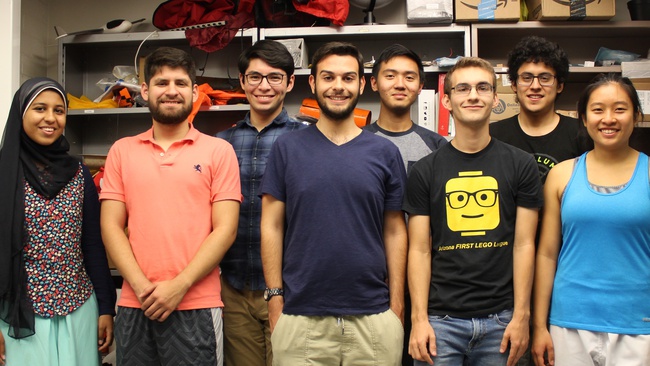In order to execute the mission objectives, the 3U CubeSat will carry 27 1F FemtoSats that will be deployed while in orbit after the CubeSat’s ejection from the launch vehicle. While stored within the 3U CubeSat, the 27 FemtoSats will be arranged in a 3x3 grid. Each FemtoSat will be held in place by a small mechanical clamp, and the whole grid will be secured by the CubeSat’s deployable solar panels in order to ensure the components do not come apart during launch. The FemtoSats will separate from the main CubeSat using weak springs that will deploy the entire grid of FemtoSats at once. Once the grid is an appropriate distance from the CubeSat, springs between the individual FemtoSats will separate them into a dispersed array. Once the FemtoSats are dispersed from the main CubeSat, the mesh wireless network will be established.
As mentioned before, the solar panels will fold out from the side of the CubeSat. The solar panels attached to the body will have magnetorquers in order to be able to spin into place to communicate with the ASU Ground Station and position itself properly towards the sun. The solar panels in question currently being looked at are Solar Panels X/Y and Z MTQ from EnduroSat. For the FemtoSats, a custom solar panel array will be implemented that may encapsulate all sides of the cube because of the potential lack of position control in the FemtoSats. Some experiments may look into position control for the FemtoSats however. In general, all of the components comprising each FemtoSat experiment will consist of completely custom made parts since commercial off the shelf parts do not yet exist for FemtoSats which this mission hopes to set the stepping stones to change in the future. The FemtoSat standard developed by SpaceTREx is attached to this submission.
This would be one of the first demonstrations of a mesh wireless network will satellites as small as a FemtoSat.
As defined by the SpaceTREx laboratory stationed at Arizona State University, a FemtoSat is a 3x3x3 cm cube. The size of a 3U CubeSat is 10x10x30 cm. The total mass of the payload will be 4.75 kg. After the deployment of the FemtoSats, the CubeSat will lose approximately a third of its volume.
The need for mesh wireless networks is increasing and ThunderBIRD seeks to add to the technology maturing behind mesh wireless network. By advancing the Technology Readiness Level of miniature mesh wireless networks in space, Special Operations Forces missions can use our telemetry data and mission outcomes to better inform future mesh wireless network designs.
None, it is estimated that any batteries we will have onboard will be under 100W-hrs as per the standard. To further comply with the Cal-Poly standard, all of the FemtoSat batteries will have an off switch triggered by transmitter command from the ground station.
Since the mission is designed to carry out over a few months at max, thermal control will be kept to a minimum and will most likely be taken care of by passive heaters on the stacked PCBs. Since radiation shielding is of little concern in low Earth orbit, we will not provide the CubeSat or FemtoSats with shielding. This will serve to further test the FemtoSat standard.
The data transfer rate between the main CubeSat and the ground station will most likely only be 9600 baud rate since the data received from each experiment will be constrained to just serial data.
In order to facilitate “live” monitoring of the experiment data for each FemtoSat, the main CubeSat will store the data as it comes in. It will then transfer the data to the ground station established at ASU’s ISTB IV building whenever in line of sight/range.
Regarding the deployable FemtoSats, each of them will most likely not have an ADCS system within place due to the constrained space requirements of each.
This is not necessarily a platform accommodation as more of a note on the development of the CubeSat. There are plans to have teams of high school students work alongside the team pictured above. Each team will be tasked with designing an experiment that will run within the FemtoSat space and deliver data that can be transmitted back to the main CubeSat and then the ground station. This major outreach component will allow for high school students to have a hand in creating parts of a satellite and get hands on experience. Each student team will be given limits on their design as per the CubeSat and FemtoSat standard. A core member of the ThunderBIRD team (pictured above) will mentor each group. A designated school of interest that already has an engineering and biotechnology focused curriculum is the Center for Research in Engineering, Science, and Technology (CREST) in northern Phoenix, Arizona.
Regarding the main CubeSat, all of the internal components except the chassis can be built with off the shelf items. The chassis will need an opening on the lower third of its volume that will deploy the 27 FemtoSats. This hatch opening will need to work in conjunction with the panels as the CubeSat configures itself in orbit. It will still be made of 6061 aluminum as per the standard.
All of the components for the FemtoSats will need to be developed by the team. This includes, the chassis, boards, and experiment chambers for each FemtoSat. The FlatSat will need to demonstrate a full run through of all the experiments with the mesh wireless network in place on the ground before moving onto flight hardware.
